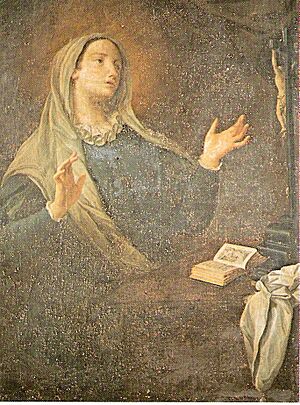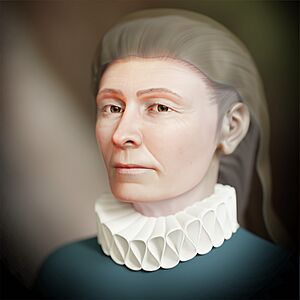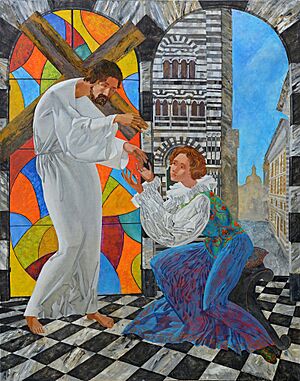Catherine of Genoa facts for kids
Quick facts for kids SaintCatherine of Genoa |
|
|---|---|
 |
|
| Saint | |
| Born | c. 1447 Genoa, Republic of Genoa |
| Died | 15 September 1510 (aged 62–63) Genoa, Republic of Genoa |
| Venerated in | Catholic Church Anglican Communion |
| Beatified | 6 April 1675, Rome, Papal States by Pope Clement X |
| Canonized | 16 June 1737, Rome, Papal States by Pope Clement XII |
| Feast | 15 September |
| Patronage | Italian hospitals |
Catherine of Genoa (born Caterina Fieschi Adorno, 1447 – 15 September 1510) was an Italian Catholic saint. She is known for her deep spiritual experiences and her work helping the sick and poor. Catherine came from a noble family in Genoa. She spent most of her life and money caring for people, especially during the bubonic plague outbreaks in Genoa in 1497 and 1501. She passed away in Genoa in 1510.
Her story became well-known after a book about her life and teachings was published in 1551. It was called Life and Doctrine of Saint Catherine of Genoa.
Contents
Early Life in Genoa
Catherine was born in Genoa in 1447. She was the youngest of five children. Her parents, Jacopo Fieschi and Francesca di Negro, came from important Italian families.
When Catherine was about 13, she wanted to join a convent (a place where nuns live). She might have been inspired by her sister, Limbania, who was a nun. However, the nuns said she was too young to join. After this, Catherine did not try again for a while.
In 1463, when she was 16, her father passed away. Catherine was then married to Giuliano Adorno, a young nobleman from Genoa. This marriage was likely arranged to help end a disagreement between their families.
Their marriage was not a happy one. They did not have children. Giuliano was not always kind and spent a lot of money. Catherine spent the first five years of her marriage quietly and sadly. For another five years, she tried to find comfort in worldly things. After ten years of marriage, she felt very unhappy. She even prayed to God to keep her sick in bed for three months, but her prayer was not answered.
A Change of Heart
After ten years of marriage, Catherine had a powerful spiritual experience. This happened during a confession on March 22, 1473. She felt an overwhelming sense of God's love for her. After this moment, she left the church without finishing her confession.
This experience marked the start of her new life. She felt a very close connection with God through prayer. She began to receive Communion almost every day. This was very unusual for ordinary people back then.
Catherine also started helping sick people at a hospital in Genoa. Her husband, Giuliano, also had a spiritual change and joined her in helping others. He later became a member of a religious group called the Third Order of Saint Francis. Catherine, however, did not join any specific religious order.
Because of her husband's spending, they had lost their money. So, Catherine and Giuliano decided to live at the Pammatone, a large hospital in Genoa. They dedicated themselves to helping people there. Catherine eventually became the manager and treasurer of the hospital.
She passed away on September 15, 1510. She was tired from all her hard work and spiritual struggles. Her death was slow and painful, with many days of suffering.
Her Spiritual Ideas
For about 25 years, Catherine had a very personal relationship with God. She felt guided by "interior inspiration." Towards the end of her life, a priest named Father Marabotti became her spiritual guide. He had been a director at the hospital where her husband died in 1497. Catherine explained her spiritual experiences to him, and he wrote them down in what became known as the Memoirs.
In 1551, 41 years after she died, a book about her life and teachings was published. It was called Book of the marvellous life and holy teaching of the Blessed Catherine of Genoa. This book includes her Dialogues on the Soul and the Body and her Treatise on Purgatory. While some parts of these writings were put into their final form after her death, many of the ideas came directly from Catherine.
Catherine's ideas about purgatory were quite unique for her time. Purgatory, in Catholic belief, is a place or state where souls are purified before going to heaven.
Becoming a Saint
Catherine's writings were carefully studied by church leaders. They decided that her teachings showed how holy she was. Because of this, she was officially declared "Blessed" (a step towards sainthood) in 1675 by Pope Clement X. She was then made a "Saint" in 1737 by Pope Clement XII.
Her writings also inspired other important religious figures. Catherine of Genoa's special day, or feast day, is celebrated on September 15. In 1942, Pope Pius XII named her the patron saint of hospitals in Italy.
In 2022, Catherine was also added to the Episcopal Church liturgical calendar, with her feast day on September 15.
See also
- List of Catholic saints
Images for kids






